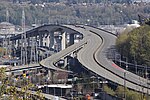West Spokane Street Bridge

The West Spokane Street Bridge was a pair of bascule bridges that crossed the west fork of the Duwamish River in Seattle, Washington, United States. The bridges connected the SoDo and West Seattle neighborhoods over the river. The original bridge opened to traffic in 1924; a second bridge carrying eastbound traffic was opened in 1930, with the 1924 bridge reconfigured to carry westbound traffic. Both bridges carried traffic until 1978, when a freighter rammed into the 1924 bridge; the 1930 bridge was subsequently reconfigured to handle two-way traffic as a result. The 1930 bridge was replaced in official capacity by the higher-level Jeanette Williams Memorial Bridge (a.k.a. the West Seattle Bridge) in 1984. The 1930 span of the bridge was closed in 1989 and subsequently demolished to make way for a lower swing bridge connecting West Seattle to Harbor Island (now known as the Spokane Street Bridge, which opened in 1991).
Excerpt from the Wikipedia article West Spokane Street Bridge (License: CC BY-SA 3.0, Authors, Images).West Spokane Street Bridge
Southwest Spokane Street, Seattle
Geographical coordinates (GPS) Address Nearby Places Show on map
Geographical coordinates (GPS)
| Latitude | Longitude |
|---|---|
| N 47.571388888889 ° | E -122.35333333333 ° |
Address
Spokane Street Bridge
Southwest Spokane Street
98134 Seattle
Washington, United States
Open on Google Maps








